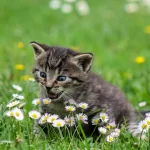These are the 20 awesome brown Cat breeds that you should know. You will get to know the characteristics and everything that concerns it. Brown cats come in all kinds of earthy shades. The color is expressed from a genetic mutation of single recessive color genes, sometimes thought to be diluted black. Although the Havana Brown cat is the only truly, completely chocolate color cat, several other cats are predominantly brown.
Most “brown” cats have tabby marking, stripe, and point patterns in their coats, while cats with solid colors are typically black or white. With their color come popular names, some of which are unique for their coat.
The population of cats living on our planet is over 400+ million – this number includes wild cats, brown cat breeds, and more.
You’ll be surprised to know that around 373 million of these cats are what you can keep as pets.
1. Abyssinian
In the Abyssinian alphabet, A is active, M is mischievous and S is for super smart. The Agile and Athletic cats are known for their love of heights, lively nature, and unquenchable curiosity. With a ticked coat, large ears, wedge-shaped head, and lithe but muscular body, the Aby resembles his far distant ancestor, the African wildcat (Felis lybica). Abys come in four colors: ruddy, red (also known as sorrel), blue and fawn. Some registries also recognize the colors silver, lilac, and chocolate. Their green or gold eyes, with dark rims, offer a striking contrast.

The Aby is highly trainable and amenable to walking on a leash. Expect him to set the pace, though. This entertaining cat isn’t shy about sharing his silly side, leading to the common nickname “Aby-silly-an.” Weighing around 6 to 12 pounds makes him a medium-sized breed. Potential health problems include patellar luxation. Genetic diseases that can affect their quality of life are erythrocyte pyruvate kinase deficiency, amyloidosis, and progressive retinal atrophy. Ask breeders if their cats are tested for these diseases. A healthy Abyssinian can live for 12 to 15 years or more. This breed suffers from severe gingivitis (gum disease), known as “Aby mouth.” Stringent dental care is a must! Other grooming needs: Weekly brushing and regular nail trims.

The Bengal is wildly outgoing and one of the largest domestic breeds. Although a hybrid of an Asian leopard cat, Bengals are part of the domestic cat class. However, if you’re considering adding one to your family, the cat should be a minimum of four generations removed from wild bloodlines. Bengals are athletes through and through, being both highly active and forever on the move. Water play is something they enjoy — whether taking showers or baths, playing in the sink, or swimming alongside their humans.
Bengals are highly intelligent and adore anything that gets their brains working. Puzzle games are a big hit for them, but they can also be trained to do tricks by using the clicker method. The Bengal is the only domestic cat breed that can be found with the type of rosette markings typically seen dotting the lush coats of its true wild counterparts — ocelots, leopards, and jaguars. The rosettes appear as vivid cocoa, chocolate brown, rust, black or charcoal spots, or marbling resting on a contrasting background, such as buff, golden, sand, ivory, rust, brown, or orange.

Birmans are known for their pure white feet, in a pattern known as gloves (the white area on the front paws) and laces (the white that goes up the hind leg). Birmans are attentive and affectionate and enjoy spending time with their family. They are happy to watch television with you for an afternoon, supervise in the kitchen, or help your kids with their homework. Birmans usually enjoy being handled and love children who treat them kindly and respectfully. With seniors or anyone else who would like a laid-back cat, they can be a gentle and companionable friend.
Birmans are generally healthy, but problems that may be seen in the breed include higher than normal levels of urea, creatinine, or other waste products in the blood, which can be related to kidney disease and Cardiomyopathy (a type of heart disease). A healthy Birman can live 14 or more years. These medium-sized cats weigh 6 to 15 pounds, with males larger than females.
Chunky and full cheeked, the British Shorthair is a comfy cat: made for sitting in laps, twining around the legs as meals are prepared, and majestically stalking a toy mouse. With his large size and dignified demeanor, he has sometimes been nicknamed the Winston Churchill of the cat world. He’s best known for his easygoing, affectionate, calm, and quiet nature. True to his British heritage, it takes a lot to ruffle his fur, making him a companion of choice for almost any family.

British Shorthairs are calm and prefer to live life with four on the floor. They are unlikely to jump on counters or climb the curtains, and they have a reputation as something of a klutz. The adult British Shorthair will snooze the day away while you’re at work, but he likes to be near, next to, or on his people when they’re home.
The Devon Rex looks as if he sprang straight out of a Japanese anime film. His triangular head, oversize ears, and zany personality do little to deny that this is one unusual cat. He likes to ride on your shoulders, learn tricks, and chatter to you about his day.
Clad in short, silky, fine hair, the Devon has a coat that can feel like soft suede, or it can have a whirled and curled appearance. This social and curious cat loves the company of people and will be unhappy if left to his own devices.

If exotic-looking cats are the key to your heart, you’ll quickly fall in love with this spotted beauty. The Egyptian Mau has stripes and natural spots. It’s the only domestic breed to display such markings. And they correspond perfectly with the trio of natural colors the Egyptian Mau is found in — silver, bronze, and smoke.

Though a social, people-loving sweetheart, this gal likes things on her terms, and she’s not afraid to vocalize that fact to you — at any time, day or night. A fiercely devoted and loyal feline, the Egyptian Mau loves to spend time with her squad, but she’ll remain more faithful to her “special person.” This breed is highly athletic and rough-and-tumble.
Love the sweet and laid-back personality of the Persian but dread the thought of grooming one?
Consider the Exotic. Plush and personable, the Exotic is aptly described as “the lazy person’s Persian.” This engaging and affectionate cat has a short, thick coat that’s beautiful but easy to groom. In personality, he’s more outgoing than the Persian but still maintains a mellow vibe.

Exotics are calm and easygoing, playful but not rowdy. They like to be in the same room with you, but don’t demand attention — except for an incessant stare that you may be unable to resist.
Known as the werewolf cat, this striking breed gets her unusual coat from a natural mutation in the domestic Shorthair, which has occurred over the last 20 years in domestic cats.

Not to worry: Test results show that the Lykoi’s hair pattern is not from a disease or disorder, and this breed is healthy. The name “Lykoi cat” is Greek for wolf cat. A new breed of cat, the Lykoi passed to Championship status in TICA in 2024 in the black roan color, which is the show standard. As of 2024, the cats could be shown in the CFA under Miscellaneous Status.
This furry “cat of size” takes his name from the tall tale that he’s the result of a love match between a cat and a raccoon.

Brown tabby fur and Ringtail notwithstanding, the Maine Coon is indeed all cats — a very large armful of cats. Nicknamed the “gentle giant,” the Maine Coon is right up there with Siberians, Norwegian Forest Cats, and Ragdolls as one of the largest of pedigreed felines. The “gentle” part comes from his famous laid-back personality. Maine Coons enjoy chasing toys and will bring them back to you. If you need pest control, the Maine Coon’s “barn cat” ancestry can make him your new best friend.
The sweet and quiet Persian enjoys sitting on a lap and receiving gentle petting from her admirers. Known for her luxurious coat and affectionate manner, she prefers family members over strangers. Choose a Persian if you want a cat who’s not a climber and if you don’t mind daily grooming.

Persians prefer a quiet, serene environment. They don’t mind children who handle them carefully and respectfully. They use their soft, pleasant voice to mention politely that it’s mealtime, or that they’d like to have some play, please, with their favorite peacock feather. As long as she receives attention when you’re home, the Persian is content to rule her domain from a comfortable sofa or chair while family members are at work or school.
Tufted ears like his namesake, the bobcat, a brown-spotted tabby coat, and, of course, a bobbed tail come together in the Pixiebob, a relatively new cat breed created to give the impression of wild blood without the actual presence of it. This breed’s distinctive appearance includes white markings around the eyes that resemble spectacles; facial fur that gives the cat the appearance of sporting “mutton chops”; gold, brown, or gooseberry green eyes; a rolling gait when he walks; and a primordial belly pouch. Most Pixiebobs have some variation of a short tail, which can have kinks, knots, curlicues, or simply be straight.

These active cats prefer being at “heart level” so they can help you or keep you company in whatever you’re doing. Pixiebobs want to be with you, near you, or on you, but without being obnoxious about it. They are smart and highly trainable. Pixiebobs enjoy conversing with people.
Ragamuffins are so laid-back and sweet, you just want to eat them up. These gentle giants of the cat world love nothing more than a good lap and an admiring audience. The extremely friendly cats — that can approach or even exceed the size of a small dog — are sweet and mellow.

If you’re looking for a pet to cuddle with, these people-loving felines are the cat’s meow. Calm and easygoing, they’ll do what you want to do, whether that’s learning to walk on a leash or having a tea party with the kids. While the “rag” in the name is an allusion to a habit of going limp in people’s arms, it doesn’t mean he can be dragged around like a Ragdoll.
It’s easy to fall into the depths of a Ragdoll’s glowing, sapphire eyes, but the real enchantment of these pointed cats with the silky medium-length coat is their gentle and affectionate personality. The Ragdoll has a reputation for being a lap cat par excellence.

People looking for a quiet, laid-back cat to travel with them in an RV or be their work-at-home companion will find the people-loving Ragdoll to be a good choice. Although she won’t mind snoozing the day away if you have to go off to work, she’ll want to be with you or near you when you’re at home.
Love the look of a wild cat?

The large, active, and confident Savannah has a spotted coat and large pointed ears, giving her an exotic appearance. The Serval is in her ancestry, but she’s not wild herself. She is, however, adventurous, intelligent, and curious — a cat who’s more than a handful. Savannahs need lots of playtime, opportunities to jump and climb, and tough, sturdy toys.

Dubbed an “owl in a catsuit” by breeders, the Scottish Fold has earned a reputation as one adorable specimen given her Perma-Cheshire Cat grin, soulful yet oversized eyes, and folded ears. All Scottish Folds are born with straight ears. It’s not until they are 3 or 4 weeks of age that their ears fold downward — although sometimes they simply don’t. Scottish Folds are known to feature a very round, roly-poly aesthetic. Face, eyes, whisker pads, body — it’s all circular here.
The Siberian moves like a Bolshoi Ballet dancer, with supple grace and strength. Known as the national treasure of Russia, this large, long-haired cat hails from Siberia, which is undoubtedly why her coat consists of three dense layers. But don’t think she’ll be cool to your overtures. Siberians are affectionate, outgoing, smart, and curious.

Siberians like to play in the water and can learn to enjoy taking a bath. They also are good at learning to walk on a leash, as they are explorers by nature. These agile cats are awesome jumpers, thanks to hind legs that are slightly longer than their front legs.
This interesting cat stands out for more than his hairless and wrinkly body. He bears a distinct resemblance to an alien — a friendly one! — With his large, satellite-dish ears and multiple skin tones and patterns.

Another characteristic of the breed is a potbelly, so don’t assume that one you’re seeing is overweight. The Sphynx feels like suede beneath your hand. The Sphynx is acrobatic, devoted, lively, and mischievous. He is also affectionate and lovable, following you wherever you go, including the bathroom. Sphynx cats are sociable and enjoy meeting your neighbors, relatives, and friends.
With gem-colored eyes and a plush coat, the Tonkinese is an exotic blend of the Siamese and the Burmese.

Mischievous and affectionate, active, but also willing to snuggle in a lap, the Tonkinese wants to be your best friend. A Tonk will supervise as you prepare meals, load the dishwasher or post his latest pics and videos on Instagram and YouTube. His friendly nature makes him a good candidate for therapy visits to hospitals, schools, and other facilities.
The Turkish Angora seems to be a fairy-tale princess of a cat: beautiful, long fur; eyes as blue as a mountain lake; a loving heart. But Turkish Angoras are much, much more than they seem on the surface: more mischievous, more colorful, more intelligent, and more athletic than their looks might imply.

An affectionate nature means that the Turkish Angora will demand to be involved in everything you do, “chatting” with you about how you should do things. This cat has a sense of humor and isn’t above playing tricks on her people.
Can’t decide between a cat or a dog? Get a Turkish Van, a smart, agile, and curious cat who will play fetch and learn commands and tricks. This rare but ancient breed loves attention from his human, but he’s not about being held. This is not the breed for you if you prefer a quiet, sedate lap cat. You need to be quick on your feet with a Turkish Van around. This is a smart cat, who loves to run, play and jump, usually to the highest point in the room.

Although not big on cuddling, he does like to be petted and will follow his favorite person around. There is a reason they call this breed the “swimming cat”.




